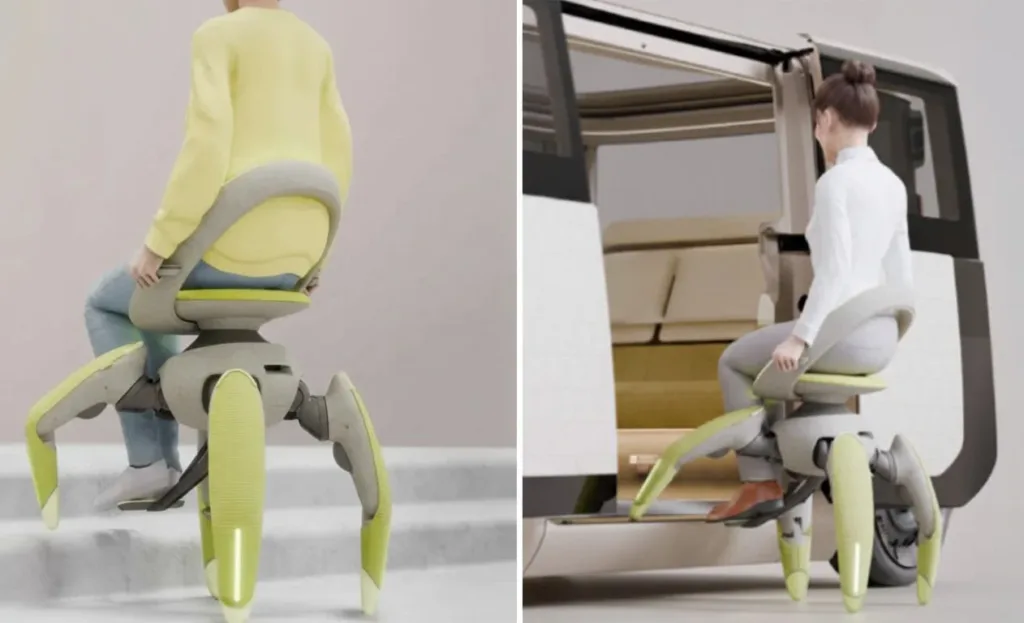Table of Contents
Toyota has once again surprised the global tech audience with an invention that merges artificial intelligence, robotics, and inclusive design into a single device. The company’s Walk Me robot chair unveiled at the Japan Mobility Show 2025 is more than a futuristic wheelchair. It’s a new symbol of mobility freedom for people with limited movement.
A New Standard in Mobility Technology
As covered by SquaredTech, Toyota’s Walk Me abandons traditional wheels in favor of four robotic legs capable of climbing stairs, crossing gravel, and adjusting to uneven surfaces. This innovation directly addresses the everyday challenges of people living in multi-level homes or areas with limited accessibility infrastructure.
The concept also highlights Toyota’s broader mission of expanding assistive robotics, positioning the company as a serious player in mobility beyond automobiles. With Walk Me, Toyota reimagines how technology can extend independence, combining advanced mechanics with user-friendly design.
Read more about our Article of Nike’s Project Amplify: The Robotic Sneaker Revolutionizing How We Move, published on October 28th 2025, SquaredTech
How Toyota’s Walk Me Robot Chair Moves Like a Living Being
Unlike a typical wheelchair that depends on continuous wheel rotation, Walk Me walks—literally. Each of its four robotic legs can bend, lift, and adapt independently. The legs are covered with soft materials to conceal their mechanical joints and sensors, ensuring a comfortable and safe appearance.
We found that this design draws inspiration from animal motion, especially creatures known for their stability on uneven surfaces. The chair’s leg movement mimics how goats and crabs maintain balance on rocks and slopes. This biomimetic principle gives Walk Me the agility to walk over small obstacles, rug edges, and garden paths without losing balance.
Each leg contains LiDAR and pressure sensors that continuously analyze the surrounding area. When the user approaches a staircase, the chair automatically identifies step height and angles. The front legs pull upward while the rear legs push from below, maintaining perfect balance through coordinated motor control.
The internal weight sensors make sure the user’s center of gravity stays aligned before any movement. If an obstacle like a pet or furniture appears, collision sensors stop the device instantly. Even during sudden tilts, the system adjusts its base to maintain full stability—the base widens and the seat tilts back to re-center the user, making the experience both safe and intelligent.
Here’s a simple technical comparison that SquaredTech compiled:
| Feature | Traditional Wheelchair | Toyota Walk Me Robot Chair |
|---|---|---|
| Mobility Mechanism | Rotating wheels | Four robotic legs |
| Terrain Compatibility | Flat, paved surfaces | Stairs, slopes, gravel, uneven floors |
| Stability Control | Manual balance | AI-driven balance sensors |
| User Interaction | Manual push or joystick | Voice commands, handles, auto navigation |
| Portability | Fixed frame | Fully foldable and compact |
This table clearly shows how Walk Me introduces a paradigm shift in mobility technology, replacing mechanical dependence with adaptive intelligence.
Comfort, Control, and Everyday Use
The Walk Me robot chair focuses equally on comfort and usability. Its seat adjusts automatically to the user’s posture, ensuring spinal support through a curved backrest. Small handles on each side allow manual steering—users can twist them for direction control or press integrated buttons for forward and reverse motion.
But Toyota didn’t stop at manual controls. For those who prefer hands-free use, voice commands make Walk Me more convenient. Simple prompts such as “Go to kitchen” or “Move faster” allow the onboard computer to map safe routes and set walking speed.

This is where the Walk Me truly shines: it integrates into life, not just movements. The chair can activate a “sit-to-floor” mode, squatting low to the ground to allow the user to transition to a floor mat or tatami. Similarly, for vehicle access, the chair can lift itself up and align perfectly with a car door, then tilt the user forward for an unassisted transfer into the footwell. This blend of autonomy and user control demonstrates Toyota’s deep commitment to accessibility.
A compact digital display on the armrest shows essential information like battery life, travel distance, and current mode. The chair’s operating system, powered by smart balance algorithms, keeps movements smooth across both indoor and outdoor surfaces.
According to data reviewed by our research team, the robot chair operates on a compact rear battery that lasts for a full day’s activity. Recharging the battery is as simple as plugging it into a wall outlet overnight. Integrated thermal sensors monitor heat levels in real time; if the system detects overheating, it automatically powers down and alerts the user through an audible tone and display message.
This safety layer proves that Toyota didn’t just focus on movement it considered real-life daily reliability.
A Folding Innovation That Fits Modern Life
One of Walk Me’s most remarkable features is its ability to fold itself automatically. With a single press of a button, the legs retract, the knees bend, and the entire chair collapses into a compact carry-on size within thirty seconds.
This transformation makes storage incredibly simple. It can fit into a car trunk, under a table, or beside furniture without taking much space. When unfolded again, the legs extend, recalibrate, and perform a balance check before instantly resuming operation.

Our editors note that this feature could be a game-changer for urban users in compact apartments or caregivers who need to transport mobility devices frequently. By merging portability and autonomy, Toyota introduces convenience without compromise.
Toyota designed Walk Me specifically for Japan’s tight living spaces and uneven outdoor environments, such as narrow hallways and small gardens. But its global potential is undeniable. From hospitals and airports to multi-level homes and office buildings, Walk Me could redefine universal accessibility standards.
What Walk Me Means for the Future of Mobility
Though Walk Me remains a prototype, its introduction at the Japan Mobility Show 2025 hints at Toyota’s long-term commitment to assistive robotics. The technology represents an intersection of AI, mechanical design, and human-centered thinking—a combination that we believes will shape the next decade of personal mobility devices.
Instead of treating accessibility tools as medical equipment, Walk Me repositions them as empowering lifestyle devices. Its ability to walk, fold, and respond to voice commands reflects a future where assistive technology blends naturally into everyday environments.
We also observes that Walk Me’s impact could extend beyond healthcare. The same underlying robotic balance system could be adapted for autonomous delivery robots, warehouse mobility platforms, and industrial applications. In other words, Toyota’s experiment could evolve into a full class of multi-terrain machines capable of working alongside humans.
The Walk Me concept also reaffirms Toyota’s evolving innovation identity. Over the past few years, the company has steadily expanded its AI research in robotics, including humanoid assistants and self-balancing transporters. This new prototype continues that trajectory, moving Toyota closer to a mobility-first future, where cars, robots, and assistive systems all share intelligent design principles.
SquaredTech’s Take: Beyond Wheels, Beyond Limits
SquaredTech views Toyota’s Walk Me as one of the most meaningful steps forward in assistive mobility since the invention of the electric wheelchair. By replacing wheels with robotic legs, Toyota breaks the physical limits of traditional design and gives mobility a new dimension—freedom of movement in places once considered inaccessible.
The Walk Me robot chair shows how artificial intelligence and mechanical precision can serve human needs in simple, tangible ways. It’s not about futuristic aesthetics; it’s about enabling independence and comfort through innovation that anyone can use.
If Toyota brings Walk Me to production, it could signal a shift where assistive technology finally matches the sophistication of mainstream consumer electronics—smart, portable, and built for real life.
From SquaredTech’s editorial perspective, the Walk Me concept doesn’t just walk—it moves the entire idea of personal mobility into a smarter future. It’s a powerful statement: the future of movement isn’t about navigating around barriers; it’s about having the technology to simply step over them.
Stay Updated: Artificial Intelligence


